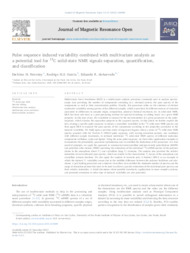Pulse sequence induced variability combined with multivariate analysis as a potential tool for 13C solid-state NMR signals separation, quantification, and classification.
Pulse sequence induced variability combined with multivariate analysis as a potential tool for 13C solid-state NMR signals separation, quantification, and classification.
Author(s): NOVOTNY, E. H.; GARCIA, R. H. S.; AZEVEDO, E. R. de
Summary: Multivariate Curve Resolution (MCR) is a multivariate analysis procedure commonly used to analyze spectroscopic data providing the number of components coexisting in a chemical system, the pure spectra of the components as well as their concentration profiles. Usually, this procedure relies on the existence of distinct systematic variability among spectra of the different samples, which is provided by different sources of variation associated to differences in samples origin, composition, physical chemical treatment, etc. In solid-state NMR, MCR has been also used as a post-processing method for spectral denoising or editing based on a given NMR property. In this type of use, the variability is induced by the incrementation of a given parameter in the pulse-sequence, which encodes the separation property in the acquired spectra. In this article we further explore the idea of using a specific pulse sequence to induce a controlled variability in the 13C solid-state NMR spectra and then apply MCR to separate the pure spectra of the components according to the properties associated to the induced variability. We build upon a previous study of sugarcane bagasse where a series of 13C solid-state NMR spectra acquired with the Torchia-T1 CPMAS pulse sequence, with varying relaxation periods, was combined with different sample treatments, to estimate individual 13C solid-state NMR spectra of different molecular components (cellulose, xylan and lignin). Using the same pulse sequence, we show other application examples to demonstrate the potentiality, parameter optimization and/or establish the limitations of the procedure. As a first proof of principle, we apply the approach to commercial semicrystalline medium density polyethylene (MDPE) and polyether ether ketone (PEEK) providing the estimation of the individual 13C ssNMR spectra of the polymer chains in the amorphous (short ) and crystalline (long ) domains. The analysis also provided the relative intensities of each estimated pure spectra, which are related to the characteristic decays of the amorphous and crystalline domain fractions. We also apply the analysis to isotactic poly (1-butene) (iPB-I) as an example in which the induced variability occurs due to the mobility difference between the polymer backbone and side-chains. A jack-knifing procedure and a student t text allow us to stablish the minimum number of spectra and the range of relaxation periods that need to be used to achieve a precise estimation of the individual pure spectra and their relative intensities. A detail discussion about possible drawbacks, applications to more complex systems, and potential extensions to other type of induced variability are also presented.
Publication year: 2023
Types of publication: Journal article
Unit: Embrapa Soils
Observation
Some of Embrapa's publications are published as ePub files. To read them, use or download one of the following free software options to your computer or mobile device. Android: Google Play Books; IOS: iBooks; Windows and Linux: Calibre.
Access other publications
Access the Agricultural Research Database (BDPA) to consult Embrapa's full library collection and records.
Visit Embrapa Bookstore to purchase books and other publications sold by Embrapa.

